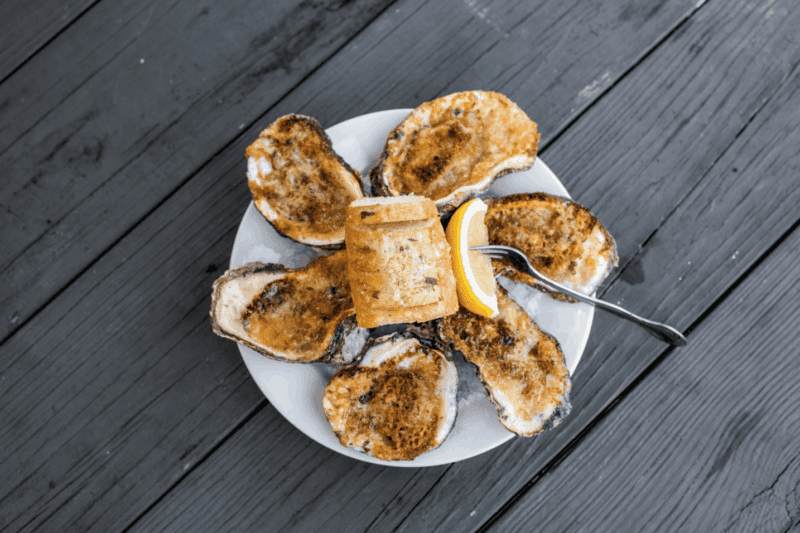To those who worship at the church of Louisiana cuisine, onions, peppers, and celery are their Holy Trinity. Together, these simple yet flavorful ingredients make the base of Cajun and Creole cuisine. This also makes it the foundation of the perfect menu for a New Orleans wedding or event. Read on to learn more about the history of this trifecta and what makes it so unique, whether you’re cooking at home or planning a New Orleans party to remember.
Defining the Holy Trinity
For chefs and home cooks in Louisiana, the Holy Trinity in cooking, which consists of onions, celery and green pepper, is the foundation of many Cajun and Creole recipes. It’s Louisiana’s take on the traditional French mirepoix that uses onions, celery and carrots.
A mirepoix combines these finely chopped aromatic vegetables that gives flavor to many French recipes. They infuse a distinctive yet subtle aromatic flavor to stews, braises, sauces and soups. The term “mirepoix” is thought to have originated with a cook for a French field marshal who was Duc de Lévis-Mirepoix.
Bell peppers may have replaced carrots when the Holy Trinity was created because they were easier to find in Louisiana at the time. This simple mixture brings a distinctive character to Holy Trinity Cajun food and Creole food.
History of the Holy Trinity Cajun Food and Creole Food’s Foundation
After the Acadians, a group of French Roman Catholics, were exiled from Nova Scotia, Canada in 1755 by the British, they made the long trip down south and settled in Louisiana. “Cajun” is slang for “Acadian,” as pronounced by English-speaking locals in Louisiana. Upon arrival, they realized the soil in their new home was not suitable for growing carrots, which was included in the “original” French Mirepoix, the Holy Trinity of carrots, onions, and celery. As they were adaptable, they quickly replaced carrots with bell peppers, which grew much easier in Louisiana. From there, the rest is history. After being diced and cooked in a pan with oil or butter, one taste will allow you to understand why this combination has lasted the test of time. While Cajun and Creole cuisine has used the Holy Trinity since then, the nickname “Holy Trinity” wasn’t solidified until chef Paul Prudhomme used it in the late 1970s.
The Holy Trinity Ratio
Typically, the Holy Trinity uses a 2:1:1 ratio of onions, celery, and peppers to fill Cajun and Creole dishes with flavor. This differs from the original French Mirepoix, which usually uses a 2:1:1 ratio of onions, celery, and carrots. Some looking to add an extra boost of flavor add garlic to the mix, so you’ll see that in a lot of New Orleans recipes. Adding garlic to the Holy Trinity is lovingly called “with the Pope.”
How to Prepare the Holy Trinity
As tasty as it is simple, making the Holy Trinity is as easy as measuring out your onions, celery, and peppers in the correct ratio, then dicing them with a knife. After your ingredients are diced and ready to go, add them to a pot with a little oil or butter and cook until fragrant and soft. Don’t forget the garlic, if you choose to add it!
How Does the Holy Trinity Affect a Dish?
In Louisiana, in contrast to the traditional mirepoix, green pepper is used instead of carrots. Here, green peppers are plentiful and easier to grow, whereas carrots do not grow well in the Louisiana heat and humidity. In a way, this was fortunate, because Louisiana’s dishes would not be the same without the bell peppers’ distinctive taste
The Holy Trinity is a staple of Louisiana dishes like etouffee, gumbo, and jambalaya. Although you can’t actually taste these veggies individually, among all the seasoning, they give soups and stews a distinctive, smoky-flavored base that turns classic dishes like red beans and rice into a delicious comfort food.
What’s an Example of the Holy Trinity in Cooking
One of the most famous examples of how the Holy Trinity in cooking shapes the taste of a dish is traditional New Orleans red beans and rice. Years ago, housewives did the laundry every Monday, a time-consuming task when they had to wash every item separately in a washtub full of hot water using a washboard.
They needed a dinner that would basically cook itself while they washed clothes out back. Also, because Sunday was the biggest and fanciest meal of the week, there was almost always leftover meat or bones. That meat typically wound up in Monday’s red beans and rice. Often the meat was a large ham which supplied a pile of leftovers along with a ham bone.
To this day, the once humble yet scrumptious dish is served up for dinner every Monday in New Orleans homes, at community gatherings, and in restaurants because it’s just that good. What makes it so amazing is the strong base supplied by the Holy Trinity veggies.
Where Did the Holy Trinity Come From?
Holy Trinity-style bases for cooking exist in various forms throughout the world Each version has its own twist. France has the mirepoix and Italy has the soffritto, both of which combine onion, celery and carrots. Germany has the suppengrün that combines leeks, carrots and celery root. Spain has the sofrito with onions, bell pepper, and tomatoes (among many other variations found within the Spanish diaspora). Similarly, Louisiana has the Holy Trinity of onions, bell pepper, and celery.
Spanish cooking was the basis of many dishes in the Caribbean, and it was brought to New Orleans by immigrants from that region. As time went by, the already strong French and Spanish influence on Louisiana cuisine was further enhanced by Haitian immigrants. They brought their love of red beans, and had their own equivalent of sofrito, a blend of spices, onions, garlic, and other ingredients, known as epis. This combination of cultures was the origin of the power of the Holy Trinity Cajun food and also Creole dishes owe so much to, and it is still a major basis of these cuisines today.
Is Garlic Important for the Holy Trinity in Cooking?
As mentioned above, another element frequently found with the Holy Trinity is garlic, otherwise known as “the Pope.” The name is no doubt due to the strong Catholic influence in New Orleans.
Adding garlic turbocharges Holy Trinity recipes, and it may even have some health benefits. What makes garlic such a good addition to Holy Trinity New Orleans food? Garlic’s taste ranges from pungent to sweet, depending on how much you cook it, but it adds a different pop of flavor when contrasted with the taste of the Holy Trinity vegetables.
Popular Holy Trinity Dishes Featuring The Pope
What are Some of the Most Popular Holy Trinity Dishes?
Some of the most widely recognizable Holy Trinity New Orleans food examples include these favorites:
-
Gumbo
-
Red Beans and Rice
-
Etouffee
-
Jambalaya
-
Fricassee, and many more!
There are many iconic New Orleans foods that start with the Holy Trinity as a base, and many that also prominently feature garlic. Let’s have a look at some well-known examples.
Gumbo
There is perhaps no food more synonymous with Louisiana than gumbo, a thick, delicious stew. While family recipes may differ, there are generally two major varieties, the Cajun and the Creole, with the main difference being that Creole gumbo contains tomatoes, while Cajun gumbo does not. This hearty stew has a complex flavor that you will never forget and will want to taste again and again.
New Orleans Red Beans and Rice
As a classic example of the Holy Trinity in cooking with plenty of garlic thrown in, red beans and rice is a good starting point. This is a dish that New Orleans is famous for, and much of its deep smoky flavor is attributable to the veggies and to copious use of garlic. If your house smells like garlic during the simmering process, you’re on the right track.
As the concoction brews, the long, slow simmer causes the Trinity vegetables to break down completely. All that’s left is a rich and creamy red bean gravy. If the process is done properly, there will be no visible indication that there were any veggies in the mix to begin with.
Stove time for red beans and rice is hours long, but once you get the base going, you can pretty much leave it alone. It will take care of itself, and you can do the laundry, read a book, or pass the time however you please. At the end of the day, you’ll have a feast in a pot that took only minutes of actual preparation time.
Etouffee
Etouffee is a French word that means smothered, suffocated, or stuffed. This hearty and delicious dish is smothered in spicy sauce and guaranteed to warm you up on a cold night. Etouffee is typically made with peeled crawfish tails or shrimp, and it achieves its savory flavor using the Holy Trinity and plenty of garlic as the base.
Etouffee is similar to gumbo, but it’s easier to make, and it takes less time to prepare. Both dishes are served over rice, and they both taste like you spent hours in the kitchen. Like gumbo, etouffee is made from a roux.
Jambalaya
Jambalaya is another iconic New Orleans dish. Made with rice, protein such as chicken and andouille sausage, the Holy Trinity, and a variety of spices. The dish was created in the 18th century and may be related to the Spanish rice dish, paella, but its origins are unique to Louisiana.
If you’ve not yet explored the delectable world of Holy Trinity Cajun food and Creole food, you should start now. Life is too short to wait.
Elysian Events Catering Prepares The Most Delicious New Orleans Dishes For Your Event
Want to serve a menu of traditional New Orleans food with a modern twist that wow your friends and family? If you’re looking for custom wedding and event catering in New Orleans, contact the experienced team of professionals at Elysian Events Catering. With a deep love of all things New Orleans, our team offers fresh, approachable dishes full of the Holy Trinity and other Cajun spices. Plan your next event with us and get ready to enjoy an experience infused with the flavors of New Orleans.





